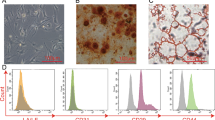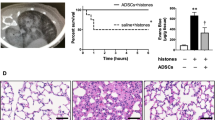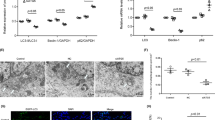Abstract
Hyperoxia-induced lung injury (HILI) tends to develop bronchopulmonary dysplasia. Adipose-derived mesenchymal stem cell (ADMSC)-derived extracellular vesicles (EVs) hold great promise in alleviating lung injury. This study explored the mechanism of ADMSC-EVs in HILI. ADMSC-EVs were isolated and identified. The murine and cell models of HILI were established. HILI mice and cells were pre-treated with ADMSC-EVs. The lung dry/wet ratio, pathological structure, apoptosis, and inflammation of HILI mice were measured. The viability, apoptosis, and oxidative stress of HILI cells were measured. The internalization of EVs in lung and cells was observed by fluorescence labeling. The binding relationships between miR-21-5p and SKP2, and Nr2f2 and C/EBPα were analyzed. The binding of SKP2 and Nr2f2 and the Nr2f2 ubiquitination level were detected. ADMSC-EVs exerted preventive effects on HILI mice, evidenced by reduced lung dry/wet ratio, inflammation, and apoptosis in HILI mice. In vitro, EVs enhanced HILI cell viability and reduced apoptosis, inflammation, and oxidative stress. EVs carried miR-21-5p into lung cells to upregulate miR-21-5p expression and thereby target SKP2. SKP2 bound to Nr2f2 and promoted its ubiquitination degradation. EVs inhibited the binding of Nr2f2 and C/EBPα and further suppressed C/EBPα transcription. Collectively, ADMSC-EVs carrying miR-21-5p alleviated HILI via the SKP2/Nr2f2/C/EBPα axis.
Graphical Abstract

Role and mechanism of adipose-derived mesenchymal stem cell-derived extracellular vesicles in hyperoxia-induced lung injury. ADMSC-EVs upregulated miR-21-5p expression in cells by carrying miR-21-5p into lung cells, thereby promoting the binding of miR-21-5p and SKP2 mRNA, inhibiting the expression of SKP2, reducing the ubiquitination level of Nr2f2, increasing the expression of Nr2f2, promoting the binding of Nr2f2 and the C/EBPα promoter, upregulating C/EBPα mRNA level, and eventually alleviating HILI.









Similar content being viewed by others
Data Availability
The data that support this study are available from the corresponding author upon reasonable request.
Code Availability
Not applicable.
References
Zyrianova, T., Lopez, B., Olcese, R., Belperio, J., Waters, C. M., Wong, L., et al. (2020). K2P2.1 (TREK-1) potassium channel activation protects against hyperoxia-induced lung injury. Scientific Reports, 10(1), 22011.
Mitchell, A., Wanczyk, H., Jensen, T., & Finck, C. (2020). Human induced pluripotent stem cells ameliorate hyperoxia-induced lung injury in a mouse model. American Journal of Translational Research, 12(1), 292–307.
Wang, J., & Dong, W. (2018). Oxidative stress and bronchopulmonary dysplasia. Gene, 678, 177–183.
Chen, S., Wu, Q., Zhong, D., Li, C., & Du, L. (2020). Caffeine prevents hyperoxia-induced lung injury in neonatal mice through NLRP3 inflammasome and NF-kappaB pathway. Respiratory Research, 21(1), 140.
Balany, J., & Bhandari, V. (2015). Understanding the impact of infection, inflammation, and their persistence in the pathogenesis of bronchopulmonary dysplasia. Frontiers in Medicine (Lausanne), 2, 90.
Kawaguchi, T., Yanagihara, T., Yokoyama, T., Suetsugu-Ogata, S., Hamada, N., Harada-Ikeda, C., et al. (2017). Probucol attenuates hyperoxia-induced lung injury in mice. PLoS One, 12(4), e0175129.
Zhang, Y., Du, H., Yu, X., & Zhu, J. (2020). Fucoidan attenuates hyperoxia-induced lung injury in newborn rats by mediating lung fibroblasts differentiate into myofibroblasts. Annals of Translational Medicine, 8(22), 1501.
Mei, Y., Chen, C., Dong, H., Zhang, W., Wang, Y., Chi, M., et al. (2018). Treatment of Hyperoxia-induced lung injury with lung mesenchymal stem cells in mice. Stem Cells International, 2018, 5976519.
Zheng, G., Huang, L., Tong, H., Shu, Q., Hu, Y., Ge, M., et al. (2014). Treatment of acute respiratory distress syndrome with allogeneic adipose-derived mesenchymal stem cells: A randomized, placebo-controlled pilot study. Respiratory Research, 15, 39.
Marzouni, E. T., Dorcheh, S. P., Nejad-Moghaddam, A., Ghanei, M., Goodarzi, H., Hosseini, S. E., et al. (2020). Adipose-derived mesenchymal stem cells ameliorate lung epithelial injury through mitigating of oxidative stress in mustard lung. Regenerative Medicine.
Keshtkar, S., Azarpira, N., & Ghahremani, M. H. (2018). Mesenchymal stem cell-derived extracellular vesicles: Novel frontiers in regenerative medicine. Stem Cell Research & Therapy, 9(1), 63.
S ELA, Mager I, Breakefield XO, Wood MJ. (2013). Extracellular vesicles: Biology and emerging therapeutic opportunities. Nature Reviews. Drug Discovery, 12(5), 347–357.
Mizuta, Y., Akahoshi, T., Guo, J., Zhang, S., Narahara, S., Kawano, T., et al. (2020). Exosomes from adipose tissue-derived mesenchymal stem cells ameliorate histone-induced acute lung injury by activating the PI3K/Akt pathway in endothelial cells. Stem Cell Research & Therapy, 11(1), 508.
Gao, Y., Sun, J., Dong, C., Zhao, M., Hu, Y., & Jin, F. (2020). Extracellular vesicles derived from adipose mesenchymal stem cells alleviate PM2.5-induced lung injury and pulmonary fibrosis. Medical Science Monitor, 26, e922782.
Carbonell, T., & Gomes, A. V. (2020). MicroRNAs in the regulation of cellular redox status and its implications in myocardial ischemia-reperfusion injury. Redox Biology, 36, 101607.
Xing, Y., Fu, J., Yang, H., Yao, L., Qiao, L., Du, Y., et al. (2015). MicroRNA expression profiles and target prediction in neonatal Wistar rat lungs during the development of bronchopulmonary dysplasia. International Journal of Molecular Medicine, 36(5), 1253–1263.
Shah, D., Sandhu, K., Das, P., Aghai, Z. H., Andersson, S., Pryhuber, G., et al. (2020). miR-184 mediates hyperoxia-induced injury by targeting cell death and angiogenesis signalling pathways in the developing lung. The European Respiratory Journal.
Qin, S., Wang, H., Liu, G., Mei, H., & Chen, M. (2019). miR215p ameliorates hyperoxic acute lung injury and decreases apoptosis of AEC II cells via PTEN/AKT signaling in rats. Molecular Medicine Reports, 20(6), 4953–4962.
Qin, S., Chen, M., Ji, H., Liu, G. Y., Mei, H., Li, K., et al. (2018). miR215p regulates type II alveolar epithelial cell apoptosis in hyperoxic acute lung injury. Molecular Medicine Reports, 17(4), 5796–5804.
Li, J. W., Wei, L., Han, Z., & Chen, Z. (2019). Mesenchymal stromal cells-derived exosomes alleviate ischemia/reperfusion injury in mouse lung by transporting anti-apoptotic miR-21-5p. European Journal of Pharmacology, 852, 68–76.
Li, P., Kaslan, M., Lee, S. H., Yao, J., & Gao, Z. (2017). Progress in Exosome Isolation Techniques. Theranostics, 7(3), 789–804.
Lozon, T. I., Eastman, A. J., Matute-Bello, G., Chen, P., Hallstrand, T. S., & Altemeier, W. A. (2011). PKR-dependent CHOP induction limits hyperoxia-induced lung injury. American Journal of Physiology. Lung Cellular and Molecular Physiology, 300(3), L422–L429.
Murakami, K., McGuire, R., Cox, R. A., Jodoin, J. M., Bjertnaes, L. J., Katahira, J., et al. (2002). Heparin nebulization attenuates acute lung injury in sepsis following smoke inhalation in sheep. Shock, 18(3), 236–241.
Li, Z., Gong, X., Li, D., Yang, X., Shi, Q., & Ju, X. (2020). Intratracheal transplantation of amnion-derived mesenchymal stem cells ameliorates Hyperoxia-induced neonatal Hyperoxic lung injury via aminoacyl-peptide hydrolase. International Journal of Stem Cells, 13(2), 221–236.
Livak, K. J., & Schmittgen, T. D. (2001). Analysis of relative gene expression data using real-time quantitative PCR and the 2(-Delta Delta C(T)) method. Methods, 25(4), 402–408.
Li, J. H., Liu, S., Zhou, H., Qu, L. H., & Yang, J. H. (2014). starBase v2.0: Decoding miRNA-ceRNA, miRNA-ncRNA and protein-RNA interaction networks from large-scale CLIP-Seq data. Nucleic Acids Research, 42(Database issue), D92–DD7.
Agarwal V, Bell GW, Nam JW, Bartel DP. (2015). Predicting effective microRNA target sites in mammalian mRNAs. Elife, 4.
Miranda, K. C., Huynh, T., Tay, Y., Ang, Y. S., Tam, W. L., Thomson, A. M., et al. (2006). A pattern-based method for the identification of MicroRNA binding sites and their corresponding heteroduplexes. Cell, 126(6), 1203–1217.
Chen, Y., & Wang, X. (2020). miRDB: An online database for prediction of functional microRNA targets. Nucleic Acids Research, 48(D1), D127–DD31.
Fornes, O., Castro-Mondragon, J. A., Khan, A., van der Lee, R., Zhang, X., Richmond, P. A., et al. (2020). JASPAR 2020: Update of the open-access database of transcription factor binding profiles. Nucleic Acids Research, 48(D1), D87–D92.
Sun, J., Ding, X., Liu, S., Duan, X., Liang, H., & Sun, T. (2020). Adipose-derived mesenchymal stem cells attenuate acute lung injury and improve the gut microbiota in septic rats. Stem Cell Research & Therapy, 11(1), 384.
Liu, X., Shen, M., Qi, Q., Zhang, H., & Guo, S. W. (2016). Corroborating evidence for platelet-induced epithelial-mesenchymal transition and fibroblast-to-myofibroblast transdifferentiation in the development of adenomyosis. Human Reproduction, 31(4), 734–749.
Gore, A., Muralidhar, M., Espey, M. G., Degenhardt, K., & Mantell, L. L. (2010). Hyperoxia sensing: From molecular mechanisms to significance in disease. Journal of Immunotoxicology, 7(4), 239–254.
Fujita Y, Kadota T, Araya J, Ochiya T, Kuwano K. (2018). Clinical application of mesenchymal stem cell-derived extracellular vesicle-based therapeutics for inflammatory lung diseases. Journal of Clinical Medicine, 7(10).
Chen, J., Hu, C., & Pan, P. (2017). Extracellular vesicle MicroRNA transfer in lung diseases. Frontiers in Physiology, 8, 1028.
Zhou, X., Chu, X., Yuan, H., Qiu, J., Zhao, C., Xin, D., et al. (2019). Mesenchymal stem cell derived EVs mediate neuroprotection after spinal cord injury in rats via the microRNA-21-5p/FasL gene axis. Biomedicine & Pharmacotherapy, 115, 108818.
Reis, M., Mavin, E., Nicholson, L., Green, K., Dickinson, A. M., & Wang, X. N. (2018). Mesenchymal stromal cell-derived extracellular vesicles attenuate dendritic cell maturation and function. Frontiers in Immunology, 9, 2538.
Mikamo M, Kitagawa K, Sakai S, Uchida C, Ohhata T, Nishimoto K, et al. (2018). Inhibiting Skp2 E3 ligase suppresses bleomycin-induced pulmonary fibrosis. International Journal of Molecular Sciences, 19(2).
Lee, S. B., Kim, J. J., Chung, J. S., Lee, M. S., Lee, K. H., Kim, B. S., et al. (2011). Romo1 is a negative-feedback regulator of Myc. Journal of Cell Science, 124(Pt 11), 1911–1924.
Jiang, Y., Liu, X., Shen, R., Gu, X., & Qian, W. (2021). Fbxo21 regulates the epithelial-to-mesenchymal transition through ubiquitination of Nr2f2 in gastric cancer. Journal of Cancer, 12(5), 1421–1430.
Zhao, G., Weiner, A. I., Neupauer, K. M., de Mello Costa, M. F., Palashikar, G., Adams-Tzivelekidis, S., et al. (2020). Regeneration of the pulmonary vascular endothelium after viral pneumonia requires COUP-TF2. Science Advances, 6(48).
Xu, Y., Saegusa, C., Schehr, A., Grant, S., Whitsett, J. A., & Ikegami, M. (2009). C/EBP{alpha} is required for pulmonary cytoprotection during hyperoxia. American Journal of Physiology. Lung Cellular and Molecular Physiology, 297(2), L286–L298.
Sun, Q., Han, W., Hu, H., Fan, D., Li, Y., Zhang, Y., et al. (2017). Hydrogen alleviates hyperoxic acute lung injury related endoplasmic reticulum stress in rats through upregulation of SIRT1. Free Radical Research, 51(6), 622–632.
Collins, A. (2020). Stem-cell therapy for bronchopulmonary dysplasia. Current Opinion in Pediatrics, 32(2), 210–215.
Jiao, B., Tang, Y., Liu, S., & Guo, C. (2020). Tetrandrine attenuates hyperoxia-induced lung injury in newborn rats via NF-kappaB p65 and ERK1/2 pathway inhibition. Annals of Translational Medicine, 8(16), 1018.
Jiang, J. S., Chou, H. C., & Chen, C. M. (2020). Cathelicidin attenuates hyperoxia-induced lung injury by inhibiting oxidative stress in newborn rats. Free Radical Biology & Medicine, 150, 23–29.
Gao, Y., & Raj, J. U. (2020). Extracellular vesicles as unique signaling messengers: Role in lung diseases. Comprehensive Physiology, 11(1), 1351–1369.
Yuan, M., Yang, X., Duscher, D., Xiong, H., Ren, S., Xu, X., et al. (2020). Overexpression of microRNA-21-5p prevents the oxidative stress-induced apoptosis of RSC96 cells by suppressing autophagy. Life Sciences, 256, 118022.
Asmamaw, M. D., Liu, Y., Zheng, Y. C., Shi, X. J., & Liu, H. M. (2020). Skp2 in the ubiquitin-proteasome system: A comprehensive review. Medicinal Research Reviews, 40(5), 1920–1949.
Xia, B., Hou, L., Kang, H., Chang, W., Liu, Y., Zhang, Y., et al. (2020). NR2F2 plays a major role in insulin-induced epithelial-mesenchymal transition in breast cancer cells. BMC Cancer, 20(1), 626.
Sato, A., Xu, Y., Whitsett, J. A., & Ikegami, M. (2012). CCAAT/enhancer binding protein-alpha regulates the protease/antiprotease balance required for bronchiolar epithelium regeneration. American Journal of Respiratory Cell and Molecular Biology, 47(4), 454–463.
Lu, H., Chen, X., Lu, Y., Zhu, H., Tang, W., & Wang, Q. (2019). Effects of C/EBPalpha overexpression on alveolar epithelial type II cell proliferation, apoptosis and surfactant protein-C expression after exposure to hyperoxia. BMC Pulmonary Medicine, 19(1), 142.
Chen, Y. D., Liu, J. Y., Lu, Y. M., Zhu, H. T., Tang, W., Wang, Q. X., et al. (2017). Functional roles of C/EBPalpha and SUMOmodification in lung development. International Journal of Molecular Medicine, 40(4), 1037–1046.
Zhu, J. J., Wu, S. H., Chen, X., Jiang, T. T., Li, X. Q., Li, J. M., et al. (2020). Tanshinone IIA suppresses hypoxia-induced apoptosis in medial vestibular nucleus cells via a Skp2/BKCa Axis. Current Pharmaceutical Design, 26(33), 4185–4194.
(2011). In: th, editor. Guide for the Care and Use of Laboratory Animals. The National Academies Collection: Reports funded by National Institutes of Health. Washington (DC).
Author information
Authors and Affiliations
Contributions
YW and ZZ made substantial contributions to the conception of the present study. JL, XW and HZ performed the experiments and wrote the manuscript; RY and ZD contributed to the design of the present study and interpreted the data. All authors read and approved the final version of the manuscript for publication.
Corresponding author
Ethics declarations
Ethics Approval and Consent to Participate
This study was performed following the approval of the Ethical Committee of the Affiliated Hospital of Southwest Medical University. All animal experiments were implemented based on the Guide for the Care and Use of Laboratory Animals [55].
Consent to Publish
Not applicable.
Conflict of Interest
The authors declare that they have no conflict of interest.
Additional information
Publisher’s Note
Springer Nature remains neutral with regard to jurisdictional claims in published maps and institutional affiliations.
Rights and permissions
About this article
Cite this article
Wu, Y., Zhang, Z., Li, J. et al. Mechanism of Adipose-Derived Mesenchymal Stem Cell-Derived Extracellular Vesicles Carrying miR-21-5p in Hyperoxia-Induced Lung Injury. Stem Cell Rev and Rep 18, 1007–1024 (2022). https://doi.org/10.1007/s12015-021-10311-x
Accepted:
Published:
Issue Date:
DOI: https://doi.org/10.1007/s12015-021-10311-x




